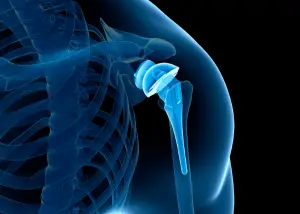Many people have total shoulder replacements, and it can be hard to know how things will turn out. Will the pain go away? Will the pain be worse after surgery? How long will the pain be present? Will I regain strength in my arm?
To answer these questions, we’ll review what’s normal, what’s abnormal, and what to expect after a total shoulder replacement including how long someone can expect to have pain and why it still might be present 6 months after surgery.
Is Pain Normal 6 Months After a Shoulder Replacement?
 Often, total shoulder replacement patients experience pain in the first few months after surgery. The type and severity of this discomfort can vary depending on person to person or even from day to day.
Often, total shoulder replacement patients experience pain in the first few months after surgery. The type and severity of this discomfort can vary depending on person to person or even from day to day.
It’s normal for total shoulder replacement patients to feel some level of discomfort during recovery. Patients should know that they may not be able to perform their usual household tasks early on in the recovery but as time progresses the pain shoulder decrease and the range of motion and strength of the shoulder begin to improve.
Pain is present typically up until the 3-month mark in most patients who have a total shoulder replacement. However, in some patients, the pain can last all the way to 1-year after the replacement surgery.
Normal Causes of Pain After a Shoulder Replacement
It’s an absolute certainty that you will have pain after a total shoulder replacement. The biggest question is for how long and why.
Some of the normal causes of pain after a shoulder replacement are healing from the surgery, weakness in the shoulder, lack of range of motion, being sedentary, not being compliant with therapy exercises, overuse, and chronic swelling in the joint.
Normal Healing from a TSA
After a total shoulder replacement, it’s normal to have pain. Usually, this will start from the first day after surgery and may not fade away until the third month of recovery. The most common cause of postoperative pain is inflammation in the joint capsule or soft tissues around your new joint which can lead to swelling as well.
In a total replacement surgery, the surgeon has to cut through ligaments, tendons, and even bone to complete the surgery. How long do you think a sawed-off bone takes to heal?

Bone will typically take 8-10 weeks to heal but the longest healing structures are the ligaments and tendons in the shoulder which can take 12 weeks or longer to fully heal. Even once those tendons and ligaments are healed there are weak and can be a common cause of pain.
Weakness in the Shoulder
It’s not unusual for total shoulder replacement patients to have quite a bit of weakness in the arm.
There are multiple muscles that work together on your rotator cuff and shoulder area that need time to heal before they can do their job again, so it’s normal if you’re weak after total shoulder replacement surgery. These muscles will typically be weaker for a year after total shoulder replacement surgery.

The muscles that make up the rotator cuff are called: Supraspinatus, Infraspinatus, Subscapularis, and Teres Minor. These muscles work together as part of a system to stabilize your shoulder joint.
The deltoid and other surrounding muscle will also be weak to the powerful motions of lifting, pushing, and pulling will be limited.
If the shoulder is too weak to perform the movements then each time you use the arm it will pull unnecessarily on other structures and cause compensations.
Poor Range of Motion After a TSA
It’s normal for total shoulder replacement patients to have a limited range of motion. The exact time in which this will improve varies, but it should increase after each week post-op. As the pain decreases and you regain more mobility in your arm, you’ll be able to do more tasks with less pain.
The total shoulder replacement surgery will change the way your arm can move and you’ll need to be patient while it heals. As you slowly improve your range of motion you will be stretching muscles, tendons, and ligaments (all of which are still healing) which is a normal cause of pain.
Being Too Sedentary After Surgery
If you don’t move, your total shoulder replacement surgery will never heal.
It’s normal to be sedentary after a total shoulder replacement due to the pain and limited range of motion which makes it difficult for some people to get back into their usual routine quickly. But as time progresses you’ll find that staying active with therapy exercises or being active in general will help with the healing process.
It’s important to stay mobile and perform a range of motion exercises for total shoulder replacement patients or their surgery won’t heal properly and you’ll have a constant ache. You’ll quickly see that your stiffness and pain feel better when you are active and moving and it’s sore and stiff if you sit and rest too long.
Not being compliant with therapy exercises
It’s not unusual for total shoulder replacement patients to be non-compliant with the therapy exercises. But if you’re trying to get better and want your arm back, it’s important that you do them as prescribed.

The total shoulder replacement surgery is a lot of work in order for it to heal properly which means there will be physical therapy exercises that you have to do.
A total shoulder replacement surgery will take between 12 and 18 months for the arm to heal completely so if you don’t follow post-operative instructions as prescribed, then it’ll take longer to fully heal which means there is a chance of getting pain again later on down the road.
Overusing the Arm After Surgery
It’s normal for an occasional overuse after a total shoulder replacement surgery. You might not be able to do much with that arm following total shoulder replacement, so it will need frequent use in order for it to heal properly and regain strength.
The issue becomes if you overuse it on a frequent basis. If you overuse it then it will be in a continual state of inflammation, pain, and muscle guarding with spasms. It’s important to stay active but it’s important to also let it heal.
Atypical Causes of Pain After a Shoulder Replacement
Sometimes there are a few causes of pain that are rare and atypical complications after a total shoulder replacement. If you feel you have any of these issues it’s important to mention it to your doctor or treating medical provider.
Chronic Swelling in the Shoulder Post Surgery
There is a chronic swelling that can occur in total shoulder replacement patients, but it’s not the norm.
It could be due to an infection or there might be so less blood flow from the total shoulder replacement surgery which causes this type of issue. But if you notice any signs of redness, tenderness, warmth around your total shoulder replacement, or you’re experiencing a fever with total shoulder replacement surgery then it’s important to mention these symptoms to your doctor.
Metal Allergy to the Prosthesis
It’s possible for total shoulder replacement patients to have a metal allergy, but it does happen.
If you notice the following signs after your surgery then speak with your doctor as this might be an indication of a metal allergy: itching skin, redness or peeling on the area where there is total shoulder replacement implantation, rash-like hives or eczema, skin that is sensitive to the total shoulder replacement implantation site.
Shoulder Prosthesis Loosening
It’s not common for total shoulder replacement patients to have a loosening of the total elbow prosthesis, but it has happened to an unfortunate number of people.
If you notice any signs that your total shoulder replacement is loose or unstable then speak with your doctor as it could be an indication that there was an issue during surgery and it needs to be addressed immediately. If this total shoulder replacement loosens, then it will put you at risk of developing a rotator cuff tear.
Signs of a Loosening Prosthesis in a Total Shoulder Replacement
- Give away of the shoulder with pressure through the hands
- “Clunking” and shifting of the arm with lifting overhead
- Sharp stabbing pain with the normal movement of the arm
- Feelings of instability or that the arm is going to “fall off”
Rotator Cuff Tear After a Shoulder Replacement
There is a risk of total shoulder replacement patients developing a rotator cuff tear after surgery.
In a standard total shoulder replacement, the surgeon typically is able to save and preserve your normal rotator cuff muscles.
In rare instances, maybe with a fall or accident lifting, you can tear the rotator cuff after the shoulder replacement. This rotator cuff tear can cause the new humeral head to have superior migration and instability in the shoulder with normal lifting activities.
Ways to Combat Chronic Pain After a Total Shoulder Replacement
A total shoulder replacement doesn’t guarantee instant relief of pain. It can take time to heal and for the muscles to strengthen again after surgery. In some cases, it could be a few months before you feel completely better. There are ways that you can help control your chronic pain levels if they do come back:
- Ice packs, cold packs, and compression wraps
- NSAIDs to help control the inflammation in your total joint replacement.
- Biofreeze is a topical cream that helps with muscle pain and swelling. You can also use this product on other joints such as your knees or elbows if you’re experiencing chronic pain there.
- Corticosteroid injections: total shoulder replacement patients can choose to have a corticosteroid injection in the total joint replacement site as well. This will help with inflammation and pain levels around that total elbow prosthesis.
- Physical Therapy post-surgery for total shoulder replacements is important, too!
Remember to speak with your doctor if you’re experiencing total shoulder replacement issues and you’re not seeing improvement.
Conclusion
If your total shoulder replacement is still causing pain or it doesn’t feel like your total elbow prosthesis has healed in the last six months, then be sure to mention these symptoms and concerns with your doctor.
Other Great Rehab and Fitness Related Articles
GLP Weight Loss and Back Health: Effective Strategies and Insights
How to Stay Active After Cervical Fractures: Expert Tips and Advice
Dealing with Painful Stairs After Ankle Replacement Surgery
Walking After a Total Ankle Replacement: Tips for a Successful Recovery
Exercises While Non-Weight Bearing After Ankle Replacement: Elevation, AROM, Leg Raises, and More
Ankle Pain with Stairs: Causes and Home Treatment Options
Disclaimer: The information provided in this post is for educational purposes only. This is not a substitute for a medical appointment. Please refer to your physician before starting any exercise program.







I’m really enjoying the design and layout of your site.
It’s very easy on the eyes which makes it much more pleasant for me to come here and visit more often. Did you hire out a designer to create your theme?
Great work!